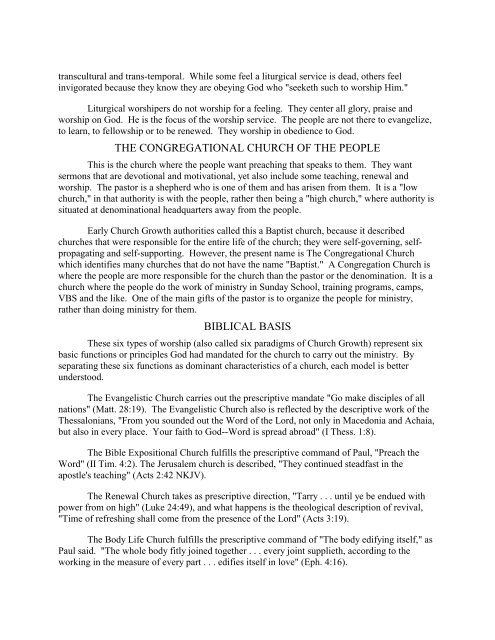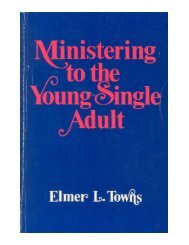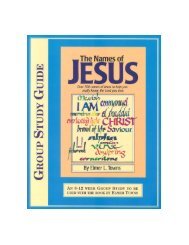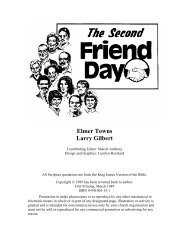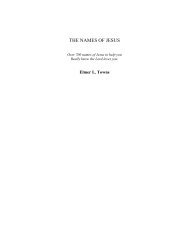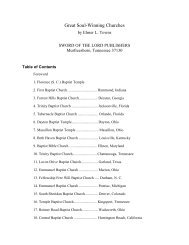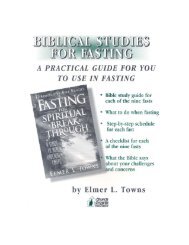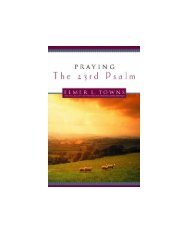PUTTING AN END TO WORSHIP WARS - Elmer Towns
PUTTING AN END TO WORSHIP WARS - Elmer Towns
PUTTING AN END TO WORSHIP WARS - Elmer Towns
- TAGS
- worship
- elmer
- towns
- elmertowns.com
You also want an ePaper? Increase the reach of your titles
YUMPU automatically turns print PDFs into web optimized ePapers that Google loves.
transcultural and trans-temporal. While some feel a liturgical service is dead, others feel<br />
invigorated because they know they are obeying God who "seeketh such to worship Him."<br />
Liturgical worshipers do not worship for a feeling. They center all glory, praise and<br />
worship on God. He is the focus of the worship service. The people are not there to evangelize,<br />
to learn, to fellowship or to be renewed. They worship in obedience to God.<br />
THE CONGREGATIONAL CHURCH OF THE PEOPLE<br />
This is the church where the people want preaching that speaks to them. They want<br />
sermons that are devotional and motivational, yet also include some teaching, renewal and<br />
worship. The pastor is a shepherd who is one of them and has arisen from them. It is a "low<br />
church," in that authority is with the people, rather then being a "high church," where authority is<br />
situated at denominational headquarters away from the people.<br />
Early Church Growth authorities called this a Baptist church, because it described<br />
churches that were responsible for the entire life of the church; they were self-governing, selfpropagating<br />
and self-supporting. However, the present name is The Congregational Church<br />
which identifies many churches that do not have the name "Baptist." A Congregation Church is<br />
where the people are more responsible for the church than the pastor or the denomination. It is a<br />
church where the people do the work of ministry in Sunday School, training programs, camps,<br />
VBS and the like. One of the main gifts of the pastor is to organize the people for ministry,<br />
rather than doing ministry for them.<br />
BIBLICAL BASIS<br />
These six types of worship (also called six paradigms of Church Growth) represent six<br />
basic functions or principles God had mandated for the church to carry out the ministry. By<br />
separating these six functions as dominant characteristics of a church, each model is better<br />
understood.<br />
The Evangelistic Church carries out the prescriptive mandate "Go make disciples of all<br />
nations" (Matt. 28:19). The Evangelistic Church also is reflected by the descriptive work of the<br />
Thessalonians, "From you sounded out the Word of the Lord, not only in Macedonia and Achaia,<br />
but also in every place. Your faith to God--Word is spread abroad" (I Thess. 1:8).<br />
The Bible Expositional Church fulfills the prescriptive command of Paul, "Preach the<br />
Word" (II Tim. 4:2). The Jerusalem church is described, "They continued steadfast in the<br />
apostle's teaching" (Acts 2:42 NKJV).<br />
The Renewal Church takes as prescriptive direction, "Tarry . . . until ye be endued with<br />
power from on high" (Luke 24:49), and what happens is the theological description of revival,<br />
"Time of refreshing shall come from the presence of the Lord" (Acts 3:19).<br />
The Body Life Church fulfills the prescriptive command of "The body edifying itself," as<br />
Paul said. "The whole body fitly joined together . . . every joint supplieth, according to the<br />
working in the measure of every part . . . edifies itself in love" (Eph. 4:16).


